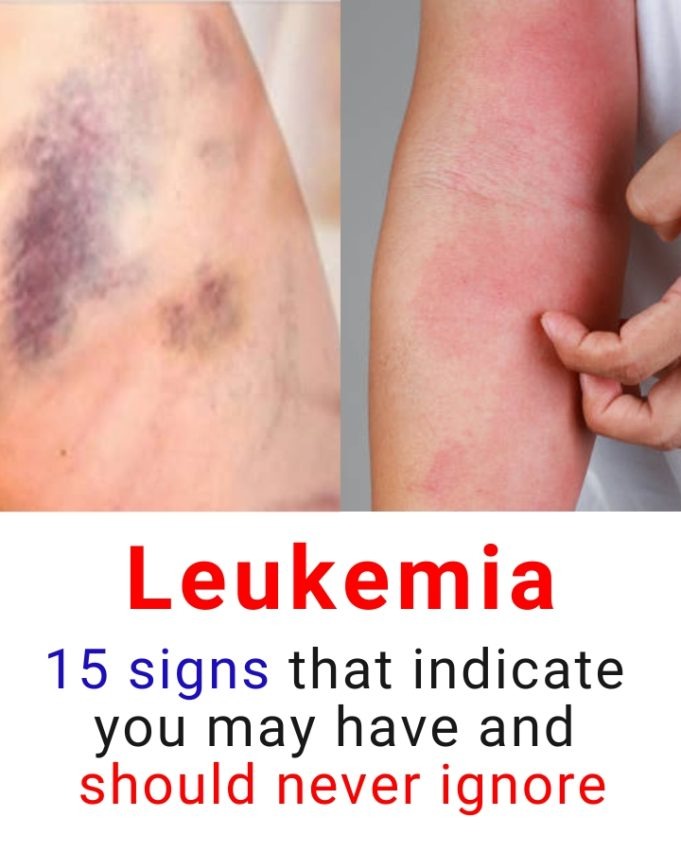
Understanding Leukemia: Early Signs, Risks, and When to Seek Help
Leukemia is a type of cancer that affects the blood and bone marrow, characterized by the abnormal production of white blood cells. It impacts millions of people worldwide, with those who have weakened immune systems facing a higher risk of developing the disease.
Without timely diagnosis and treatment, leukemia can lead to serious complications such as anemia, frequent infections, and uncontrolled bleeding.
The encouraging news? Leukemia is often treatable. Many patients respond well to medical therapies, and in some cases, achieve long-term remission or full recovery.
Early Detection: Recognizing the Symptoms of Leukemia
Detecting leukemia early can significantly improve treatment outcomes. Here are 15 symptoms commonly associated with the disease. If several of these occur together or persist, it’s important to consult a healthcare provider:
- Persistent Fatigue – Caused by reduced red blood cell production, leading to constant tiredness and lack of energy.
- Loss of Motivation – A general disinterest or emotional dullness may accompany early stages.
- Unusual Bleeding – Frequent nosebleeds or bleeding gums should not be ignored.
- Unexplained Bruising – Sudden bruises or pinpoint red/purple spots (petechiae) on the skin may be warning signs.
- Swollen Gums – Gum inflammation or overgrowth can appear as the disease progresses.
- Bloating and Loss of Appetite – Often caused by an enlarged spleen pressing on nearby organs.
- Upper Left Abdominal Pain – Discomfort in this area may indicate spleen involvement and requires medical assessment.
- Low-Grade Fever – A mild, recurring fever (around 37°C) occurs in roughly one-quarter of leukemia cases.
- Excessive Night Sweats – Particularly when not caused by heat or activity.
- Facial Paralysis – Rare, but possible; may also indicate neurological involvement or a stroke—urgent care is needed.
- Pale Skin and Drowsiness – Common signs of anemia, which is often associated with leukemia.
- Bone or Joint Pain – Especially persistent aches that are not due to injury or physical exertion.
- Swollen Lymph Nodes – Enlarged nodes in the neck, armpits, or groin could indicate an immune or blood-related condition.
- Skin Rashes – Leukemia can cause visible skin changes or persistent rashes.
- Frequent Infections – A weakened immune response can lead to recurring colds, respiratory infections, or more serious illnesses.
If you or someone close to you is experiencing multiple symptoms from this list, seek medical advice promptly.
Important Disclaimer:
This guide is for informational purposes only and should not replace medical advice. If you have health concerns or notice new symptoms, consult a qualified healthcare professional for proper evaluation and diagnosis.
7 Critical Symptoms That May Signal Life-Threatening Conditions
Sometimes, our bodies show signs that something is dangerously wrong. While not every symptom means something serious, there are certain red flags that should never be ignored. These 7 signs could indicate a severe or even life-threatening condition—and in some cases, may point to the body beginning to shut down.
1. Unexplained Weight Loss
Losing more than 5–10% of your body weight over a few months without dietary or activity changes can be a warning sign. Potential causes include:
- Cancers (especially of the stomach, lung, pancreas, or colon)
- Thyroid disorders
- Chronic infections
Seek evaluation if you’re losing weight unintentionally.
2. Persistent, Severe Fatigue
Fatigue that doesn’t improve with rest and affects daily function can signal:
- Heart, liver, or kidney disease
- Anemia
- Cancers such as leukemia
Especially concerning when accompanied by dizziness or shortness of breath.
3. Shortness of Breath at Rest
Difficulty breathing—even while inactive—may suggest:
- Heart failure
- Lung disease (COPD, fibrosis)
- Pulmonary embolism
Sudden onset requires immediate emergency care.
4. Chest Pain or Pressure
Pain or pressure in the chest that radiates to the left arm, neck, jaw, or back could mean:
- Heart attack
- Angina
- Aortic dissection or pericarditis
Don’t wait—get emergency help right away.
5. Sudden Confusion or Mental Changes
Abrupt memory issues, confusion, or trouble speaking can signal:
- Stroke
- Brain tumor
- Severe infection (e.g., sepsis)
In seniors, even a simple infection can trigger confusion. Time is critical—call for help immediately.
6. Severe Abdominal Pain
Pain that is sharp, persistent, or worsening—especially with vomiting or swelling—could indicate:
- Appendicitis
- Pancreatitis
- Internal bleeding
These require urgent medical intervention.
7. Uncontrolled Bleeding or Easy Bruising
If bleeding doesn’t stop or bruises appear frequently without trauma, it may point to:
- Blood disorders (e.g., leukemia, hemophilia)
- Liver failure
- Platelet deficiencies
Seek medical attention if these symptoms are new or worsening.
When to Take Action
Many of these symptoms have multiple causes—some mild, others severe. The key is to listen to your body and act early. Delaying medical attention can cost lives.
Final Thoughts
Experiencing one or more of these serious symptoms doesn’t always mean something fatal is imminent, but they often indicate underlying, serious health issues. Early detection can make all the difference. If in doubt, get checked—it could save your life or that of someone you love.
Let me know if you’d like this formatted into a downloadable document, infographic, or patient handout.


